How to Develop a Personalized AI For an Enterprise Shopping Platform
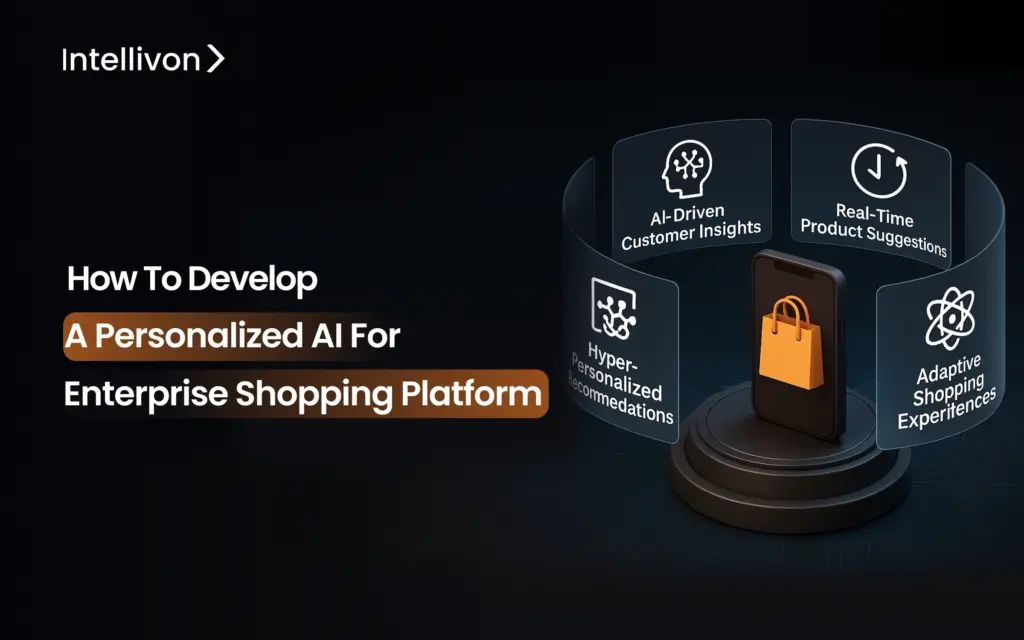
The online shopping experience has moved way past the ‘one size fits all’ circus. Consumers want online shopping to feel like an elevated experience and to be treated like VIP’s by the brand. While enterprises have adopted AI solutions to elevate shopping experiences, the average cart abandonment rate is still at a staggering 70.2%. So what are they doing wrong? The answer lies in hyper-personalized experiences customized to the T, and this can be achieved through AI-powered personalization. Take, for instance, Amazon’s AI shopping assistant Rufus. The AI assistant is projected to turn a $285 million loss in 2024 into a $1.2 billion profit by 2027, as it expands globally and becomes deeply integrated into the shopping experience. Consequently, an Accenture report shows that 91% of consumers are more likely to shop with brands that recognize them, remember their preferences, and offer relevant recommendations. All these statistics point to the growing need for customized AI personalization in the e-commerce sphere. With years of hands-on experience, Intellivon’s AI team has helped large retail enterprises build and scale personalized AI development solutions that drive real business results. By combining advanced technology with proven, science-backed methods, we create systems that deliver measurable returns. In this blog, we will walk you through how we approach enterprise-grade AI personalization from the ground up, tailored to the unique needs of retail businesses. Why Enterprises Should Adopt AI-Personalized Shopping Experiences The retail industry is witnessing rapid adoption of AI, with the market expected to reach nearly $9.65 billion in 2024 and projected to grow to $38.92 billion by 2029. This growth is fueled by the widespread use of smart devices, a growing base of internet users, increasing awareness of AI and big data, and strong support from government-led digital transformation initiatives. Key Market Insights: The global AI-based personalization market is valued at $525.2 billion in 2025 and is expected to reach $639.7 billion by 2029, growing at a rate of 5.1% annually. AI personalization engines used by retailers are forecasted to grow to $717.8 billion by 2033. Specialized sectors, like AI-powered personalization engines, are valued at $455.4 billion in 2024 and expected to reach $717.8 billion by 2033. Companies using AI for dynamic pricing have seen up to a 15% increase in revenue, while AI-driven segmentation has boosted loyalty program engagement by 11% annually. Brands like Nike, H&M, and Zara use AI chatbots and recommendation engines to offer personalized advice, increase engagement, and reduce cart abandonment by up to 30%. Over 70% of retail shopping experiences still lack AI-driven hyper-personalization, representing a major opportunity for companies to invest in AI now. A gap is still lagging in the market when it comes to AI-personalization, but enterprises are rushing to it. This is the right time for you to invest in building an AI-personalized shopping engine. Why Off-the-Shelf AI Personalization Solutions Are Failing AI-driven personalization has become essential in retail, but many solutions fall short when applied at an enterprise scale. Tools built for D2C brands often collapse under the weight of complex retail operations. Below, we explore the key reasons these generic platforms fail, and how a tailored enterprise approach makes all the difference. 1. Consumer AI Falls Apart in Enterprise Retail Most off-the-shelf AI personalization tools are designed for small to mid-sized retailers managing a few thousand SKUs and relatively simple customer journeys. These systems struggle when applied to enterprise retail, where a single platform may support over half a million products, multi-brand portfolios, and layered buyer roles. Instead of generating useful recommendations, generic AI solutions frequently produce mismatched or irrelevant suggestions. This not only disrupts the user experience but also causes friction across the purchasing process, ultimately lowering conversion rates and weakening customer trust. 2. Data Privacy and Compliance Factor Enterprise retailers must operate in full compliance with stringent data regulations. From GDPR in Europe to CCPA in California, legal requirements vary widely by geography and industry. Healthcare, financial services, and public sector clients each bring an added layer of complexity. Most consumer-grade AI systems are not built to manage these diverse regulatory demands. They lack granular access controls, proper audit trails, and flexible consent management. The result is a high risk of non-compliance that can expose businesses to severe penalties and reputational damage. 3. Legacy System Integration Challenge Retail enterprises rarely start from scratch. Most operate with deeply embedded systemsm aging ERPs, custom databases, and proprietary software that support critical day-to-day operations. Off-the-shelf AI solutions often require a full-scale overhaul to work, which introduces serious risks. Implementation may take months, create operational downtime, and rack up high costs with limited short-term value. How Intellivon Bridges the Enterprise AI Gap At Intellivon, we approach these challenges with purpose-built, modular AI architectures. Instead of forcing enterprises to reshape their systems, we design solutions that work with what already exists. Our personalization tools are built with secure, compliance-first frameworks that meet the demands of enterprise security and regulatory standards. We enable seamless integration through APIs that connect directly with platforms like SAP, Oracle, and other legacy systems. This ensures low-disruption deployment while delivering personalization that reflects the scale, complexity, and depth of enterprise retail environments. The Power of AI in Personalization for Enterprise Shopping Platforms In enterprise retail, delivering a truly personalized shopping experience requires more than simple recommendation engines. AI enables retailers to understand each customer’s intent, preferences, and context at scale, driving meaningful engagement across every touchpoint. 1. Data Collection and Behavior Tracking Enterprise AI begins with collecting data from browsing history, search queries, click patterns, purchase records, and more. This creates a real-time behavioral profile of each shopper. Lowe’s uses AI to track customer interactions across its platforms, tailoring suggestions based on DIY interests and seasonal behavior. 2. Pattern Recognition and Predictive Modeling AI systems analyze customer data to uncover patterns such as product preferences or shopping frequency. Predictive models then forecast what customers are likely to buy next. Amazon’s Rufus applies these models to suggest relevant products based on past behavior and
How to Develop Underwriting AI for InsureTech Enterprises
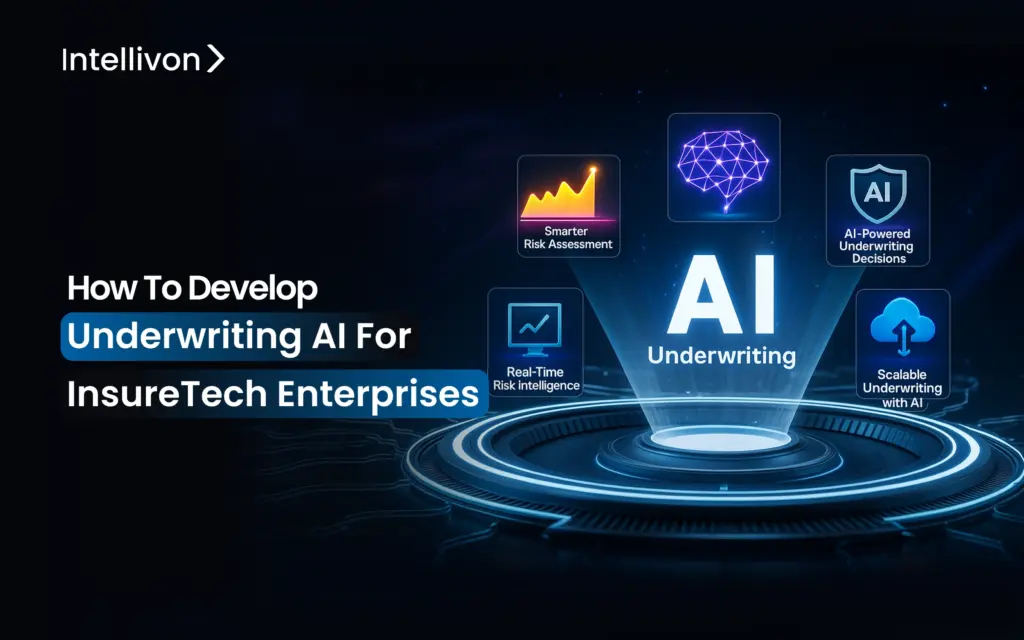
Large insurers face volumes of data, shifting customer demands, and tighter regulations, challenges that traditional underwriting systems struggle to keep up with. It’s time for a new approach that’s faster, smarter, and more adaptable. The adoption of AI in insurance underwriting is still green, but the top 25 industry leaders are already reaping its benefits. The AI handles the manual grunt work of combing through thousands of pages of actuarial data, identifying patterns of risk, and consolidating them. At the same time, the insurance underwriter uses his expertise to personalize terms and conditions for policyholders. Leading companies, such as Allianz and Hagerty, have reported a 31% reduction in processing times and a 43% improvement in risk assessment accuracy after integrating AI into their insurance underwriting processes. This suggests that the need for integrating AI into underwriting is a solution that every insurance enterprise must adopt at scale. At Intellivon, we help enterprises achieve this by developing AI insurance underwriting solutions from scratch and seamlessly integrating them into existing legacy systems without compromising proprietary data. In this blog, we will dissect how insuretech enterprises can grow with scalable AI-powered insurance underwriting solutions. The Right Time To Invest in AI-Powered Underwriting for Insurance Enterprises The global AI in insurance market is projected to grow from $7.7 billion in 2025 to $102.9 billion by 2034, with a 33.4% annual growth rate, according to a Dimension Market Research report. Key Market Drivers of this Growth: 66% of brokers say carriers must process submissions faster, accelerating the push for AI-assisted underwriting. Many insurers are moving from AI experiments to full-scale implementation and staff training for underwriting workflows. AI-driven underwriting can reduce policy approval times by up to 80%, allowing insurers to serve more customers quickly. AI has cut standard underwriting decision times from days to just 12.4 minutes, while keeping accuracy above 99% for simpler policies. AI has reduced the time required for complex policy processing by over 30% and improved predictive risk accuracy by 43%. AI adoption has led to a 50%+ increase in underwriter productivity and up to 15% revenue growth through personalized pricing and risk evaluation. Integrating IoT and telematics in underwriting can reduce claim losses by around 20%. Generative AI and Its Impact on Insurance Underwriting Generative AI is driving a significant shift in how underwriting is conducted across the insurance industry. By enabling faster decisions, better risk models, and enhanced customer experiences, it’s becoming a vital part of modern insurance operations. Here’s how: 1. Faster, Accurate Risk Modeling One of the biggest advantages of generative AI is its ability to handle complex risk scenarios. In segments like cyber insurance, predictive models powered by generative AI have reduced underwriting errors by 34%. Even better, cyber claim frequencies have dropped by up to 22%, thanks to real-time threat intelligence. These results show how well generative AI understands evolving risks. Instead of relying on outdated models, it learns from current and historical data to make better decisions quickly. 2. Quick Efficiency Gains Underwriting decisions that once took days or weeks now take just 12.4 minutes on average. This incredible time reduction is driven by AI-powered underwriting systems enhanced with generative models. For simpler policies, risk assessment accuracy has reached over 99%. Some insurers have seen up to 80% faster policy issuance, a massive operational gain. This kind of efficiency not only saves time but also lowers costs and improves customer satisfaction. 3. Rapid Market Growth and Adoption The market for generative AI in insurance is growing at an impressive pace. It was valued at around $1.08 billion in 2024 and is projected to reach approximately $1.51 billion in 2025. That’s a compound annual growth rate (CAGR) of nearly 40%. Notably, North America leads adoption, accounting for about 44% of the global market share. This dominance reflects the region’s mature InsureTech ecosystem and investment in advanced AI capabilities. 4. Real-Time Adjustments to Policies Another powerful feature of generative AI is its simulation capability. It helps insurers adjust policies on the fly, based on emerging threats or changing risk conditions. In areas like cyber insurance, these dynamic updates can be up to 84% accurate in predicting financial impacts. This leads to faster responses, better preparedness, and more resilient underwriting models. 5. Stronger Fraud Detection Fraud is a serious concern in the insurance space. Fortunately, AI in insurance is also advancing fraud detection. Generative AI can identify risk anomalies and highlight suspicious behavior before claims are processed. In addition, these models improve compliance. With explainable AI, insurers can meet regulatory requirements more transparently. This builds trust with both regulators and customers while reducing legal risk. As the market continues to grow, AI in insurance will only become more essential in underwriting innovation and enterprise success. Why Underwriting Is Complex for Insuretech Enterprises Modern insurance underwriting is more complicated than ever. For InsureTech enterprises, scaling fast while managing high-risk portfolios means dealing with complex data, instant decisions, and strict regulations. While AI in insurance offers solutions, the road to adoption is far from simple. 1. Unending Diverse Data Sources Underwriting today relies on more than just application forms and credit scores. Insuretechs must pull in and process: Structured data like financials, claims history, and demographic info Unstructured data such as doctors’ notes, social media signals, or IoT sensor logs External data from third-party risk databases, weather APIs, or credit agencies This volume and variety of data demand robust systems that can handle scale and complexity. For example, a Fortune 500 insurer managing commercial property policies must analyze building blueprints (PDFs), real-time satellite imagery, and local climate risk reports, all at once. 2. High-Stakes Real-Time Decisions Speed is no longer optional. Clients expect quotes instantly, especially for auto, health, and cyber insurance. But fast decision-making in high-risk segments means underwriting engines must be both quick and precise. Imagine a large global insurer offering cyber liability coverage to enterprise clients. Underwriters need to assess current threat exposure, past incident history, and security hygiene, all in real time. Delays
Scalable AI Document System for Enterprises
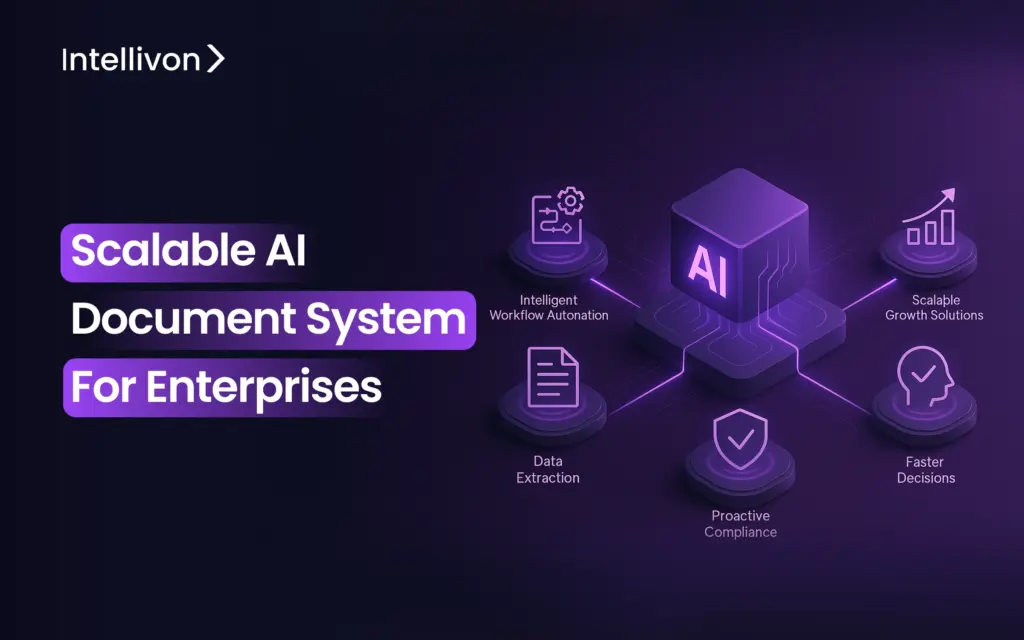
Global enterprises exchange billions of documents each year. Yet most systems treat these documents as static files, not living data. Fragmented tools, siloed systems, and compliance blind spots only add to the chaos. The outcome? Delays, errors, and frustrated teams are drowning in documents instead of unlocking their insights. For instance, 83% of employees say they’ve had to recreate files they couldn’t find, wasting a lot of time. Additionally, employees waste up to 3 hours per working day sorting through documents and manual data handling, time which could be better used for strategic decision-making. But there’s a smarter way forward. Scalable AI Document Systems transform enterprise document overload into smooth workflows. These systems turn document chaos into business clarity. Coca-Cola adopted an AI-powered documentation platform, after which data quality improved by 90%, ensuring reliable documentation across all company locations. In this blog, we will cover everything about AI enterprise document systems, from why they are important, their benefits, how Intellivon implements these systems, and some future practices to solidify them into enterprise legacy systems. Intellivon, with 11+ years of experience, is a leading AI documentation partner, providing expert solutions tailored to specific enterprise issues. What Is a Scalable AI Document System and Why Enterprises Need One Now A scalable AI document system is more than just digital storage. It’s an intelligent, self-learning solution that can ingest, classify, extract, and process documents at enterprise scale, across formats, languages, and business contexts. Unlike traditional document management systems (DMS), it understands files instead of just storing them. In real-world terms, consider this: an international bank receives hundreds of thousands of forms daily, from loan applications to compliance reports. Manually processing them leads to bottlenecks, human errors, and rising costs. Even legacy DMS tools fall short, offering basic indexing but no intelligence. This overload creates serious risks: missed deadlines, non-compliance penalties, and inefficient operations. That’s why enterprises are shifting from static, rules-based systems to AI-driven document platforms that learn and evolve. These systems use machine learning and natural language processing (NLP) to improve how they recognize, interpret, and route information. The document management systems market is expected to grow from USD 10.51 billion in 2025 to USD 19.81 billion by 2030, growing at 13.5% annually, according to Mordor Intelligence reports. 60% of enterprises are investing in AI to convert unstructured data into structured formats. By 2026, 70% of data preparation for AI projects will use automated tools, with AI-enabled data extraction and RAG being crucial. Over 50% of IDP solutions will feature advanced AI/ML capabilities by 2024. The data highlights rapid growth in AI-driven document management, with businesses quickly adopting cloud-based, scalable solutions using ML, NLP, and automation to manage growing document volumes and compliance needs. Current Challenges in Document Management for Global Enterprises Every day, your enterprise generates over 2.5 quintillion bytes of data. Yet, instead of creating clarity, this data often adds complexity. Many enterprises still rely on outdated systems that turn document management into a liability rather than an asset. Here are three urgent and interconnected challenges that your enterprise is facing right now: 1. The Data Silo Crisis Over time, enterprise systems grow in silos. You may use popular software for collaboration, legacy ECMs for compliance, and local drives for daily tasks. But these disconnected repositories limit data visibility and trust. Teams can’t easily collaborate or access unified insights. This siloed structure leads to decision-making based on incomplete or outdated information, which is a risky proposition at the executive level. 2. Increasing Compliance Costs With strict regulations like GDPR, HIPAA, and industry-specific laws, compliance is more complex than ever. Many enterprises must juggle legacy tools and manual processes just to stay audit-ready. Legal departments are increasingly burdened by document-heavy processes, with compliance activities consuming disproportionate resources compared to strategic legal work. 3. AI Integration Complexity As GenAI and agentic AI scale across enterprises, AI-readiness becomes non-negotiable. Yet, unstructured documents remain inaccessible to AI models due to poor architecture. Without intelligent document systems, even advanced algorithms can’t extract value from your data. This creates a serious gap between digital transformation goals and daily operations. The real danger? While your teams struggle with document chaos, your competitors are using AI-driven systems to gain speed, agility, and insight. The time to act is now. Why Scalable AI Document Systems are the Game Changer Traditional document systems weren’t built for today’s enterprise demands. In contrast, scalable AI document systems unlock operational efficiency, compliance resilience, and data-driven decision-making. Here’s how they redefine enterprise workflows. 1. Cutting Operational Costs with Intelligent Automation Manual document handling slows everything down. From data entry to verification, repetitive tasks consume valuable human capital. By implementing intelligent automation, enterprises can cut significant operational costs. AI document systems take over the heavy lifting, like extracting data, validating formats, and routing files instantly. As a result, your teams can focus on higher-value work that drives innovation and growth. 2. Scalable Solutions That Grow With Your Business Scalable AI systems are built to handle growth. Using cloud-native architecture, they adjust in real time to fluctuations in document volume. Whether you’re processing 10,000 invoices today or 100,000 next quarter, performance never dips. This eliminates the need for costly infrastructure upgrades and supports continuous expansion, which means no downtime, no delays. 3. Proactive Compliance with AI Systems Legacy systems respond to compliance after issues arise. AI systems flip the script. With intelligent document processing (IDP), they monitor data in real time, flag anomalies, and ensure every document meets regulatory standards. This proactive approach turns your legal department into a strategic partner, one that prevents violations before they occur. 4. Faster Decisions with Data Access AI document systems turn trapped documents into actionable intelligence. Executives no longer have to rely on partial reports from siloed departments. Instead, they gain access to a comprehensive, real-time view of business activity. This fuels faster decisions, sharper forecasting, and true competitive advantage. Advanced Features of AI Document Management Systems Modern enterprises need intelligent, adaptable systems that evolve with the pace of
How AI Can Help Assess Risk Management for Enterprise
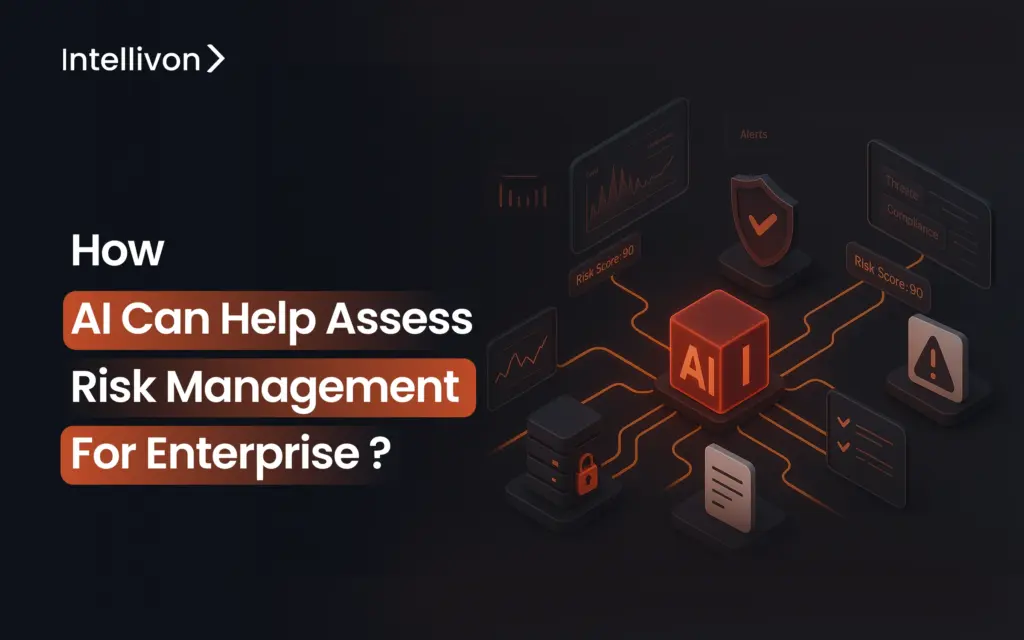
Risk management is no longer an option for enterprises to upgrade. Enterprise risk management, or ERM, in the modern data-driven space has crossed over the boundaries of finance to include operations, strategies, and reputation management. Moreover, the risk landscape can change within hours these days, which took months in the past. If a risk is not detected in time, it can lead to an unimagined crisis. Take, for instance, Southwest Airlines reported that the December 2022 systems failure cost the company approximately $800 million in the fourth quarter, which led to a net Q4 loss of $220 million. Risk managers said that had they employed predictive analytics, they could have avoided this blunder. Overall enterprise AI adoption rose from 54% in 2023 to 64% in 2024 and will continue to skyrocket as more enterprises integrate AI-powered ERM systems, which are proactive rather than reactive. If modern risks demand modern AI ERMs, why does your risk team still fight tomorrow’s threats with yesterday’s tools? In this blog, we will cover why AI-powered ERM’s outperform traditional approaches, how AI transforms ERM, key ERM-based AI tech stack, our framework for managing ERM, and some challenges to overcome. At Intellivon, we take into consideration the unique challenges your enterprise faces and align your KPIs to generate custom AI-based risk management solutions. Why Leading Enterprises Are Using AI in Risk Management The Enterprise Risk Management (ERM) market is expected to grow significantly, from USD 5.93 billion in 2025 to USD 9.36 billion by 2034. According to the Market Research Future report, this growth reflects a steady annual increase of 5.20% during the forecast period. As more and more enterprises are using AI to guide their risk management strategies, take a look at these staggering numbers: By 2024, 64% of enterprises will have adopted AI, up from 54% in 2023, with many incorporating it into risk management. In financial services, 76% of executives prioritize AI for fraud detection and prevention, and 68% focus on it for compliance and risk management. 88% of global organizations are actively measuring the value of AI adoption, focusing on ROI and impact. 98% of CEOs believe AI in risk management will bring immediate business benefits, improving decision-making and risk mitigation. AI is reshaping risk management frameworks, making them stronger and more proactive. Instead of merely reacting to crises, businesses can now predict potential risks, stop them from escalating, and make informed decisions that protect both their operations and reputation. The ability to anticipate risks is already giving organizations a competitive advantage as they move into 2025. Limitations of Traditional Risk Management Approaches In an era where data is vast and threats are more unpredictable, relying on outdated processes and rigid models leaves enterprises vulnerable to unforeseen risks. The limitations of traditional methods are becoming more apparent, exposing enterprises to the risk of blind spots, misallocated resources, and slow reactions to emerging challenges. 1. Manual Processes Create Gaps in Risk Management Traditional risk management often relies on time-consuming manual processes and periodic assessments. Typically conducted quarterly or annually, these reviews leave businesses exposed to fast-moving threats that may evolve between evaluations. Risk managers must spend considerable time compiling data and generating reports, which means real-time risks can be missed, leaving gaps in the overall risk assessment. 2. Subjective Judgment Introduces Bias Human biases can significantly skew risk assessments. Decision-makers may unintentionally prioritize risks they are most familiar with or that are more easily identifiable, while neglecting newer or less obvious threats. Cognitive biases like anchoring or availability heuristic can lead to improper risk allocations, leaving businesses vulnerable to underestimating potential dangers and misdirecting valuable resources. 3. Fragmented Information Sources In many organizations, data is trapped in various silos across departments, making it difficult to get a comprehensive view of risks. Financial data, operational metrics, and compliance information often remain isolated, and risk managers struggle to piece together seemingly unrelated data points that could indicate systemic threats. This lack of connectivity hinders the ability to see the bigger picture and respond appropriately. 4. Processing Capacity Limitations The sheer volume of data generated by modern enterprises is overwhelming. Traditional risk management systems are ill-equipped to handle this immense flow of information. They struggle to process and analyze data fast enough to detect patterns, correlations, or emerging risks in time to prevent damage. As a result, organizations can miss out on key insights that might have allowed them to respond proactively. 5. Unstructured Data Blindness Traditional risk management systems also fail to analyze unstructured data effectively. Much of the most valuable risk-relevant information resides in emails, social media, news articles, and regulatory filings, formats that conventional tools cannot process. Without the ability to capture and analyze these data sources, risk managers risk missing early warning signs that could help prevent or mitigate damage. 6. Crisis Response vs. Prevention While traditional risk management excels at responding to crises once they have materialized, it falls short when it comes to proactive prevention. By the time risks show up on conventional dashboards, the damage is often already done, and options for mitigation are limited. This reactive approach leaves businesses vulnerable to escalating threats that could have been avoided with earlier intervention. 7. Backward-Looking Analytics Many traditional risk models rely on historical data to predict future risks. However, this backward-looking approach fails to account for unpredictable, unprecedented events, such as cyberattacks or supply chain disruptions, that do not follow past patterns. Relying solely on historical data models leaves organizations unprepared for the unique challenges posed by rapidly changing environments. How AI Transforms Enterprise Risk Management AI is revolutionizing the way businesses approach risk management. By integrating cutting-edge technology, companies can move beyond reactive strategies and develop proactive, data-driven approaches to mitigate potential risks. This transformation is reshaping traditional risk management methods, empowering organizations to anticipate threats and respond strategically. 1. Predictive Analytics Replaces Reactive Firefighting AI shifts risk management from responding to crises to preventing them. Through machine learning algorithms, AI analyzes historical patterns, market trends, and operational
Custom AI Chatbot Development for Omnichannel Retail Support
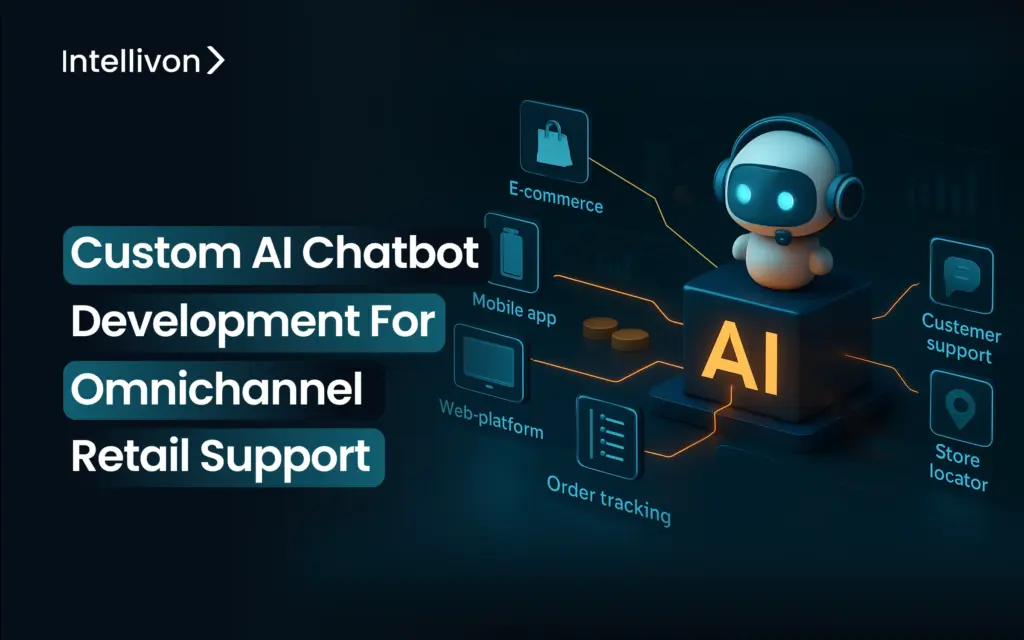
Chatbots are taking over the global retail enterprise space as customer demands evolve and hyper-personalized product suggestions become prominent. In this changing retail landscape, retail enterprises face a critical challenge: providing seamless support across multiple touchpoints. Custom AI chatbots have become a game-changer in meeting this challenge by achieving true omnichannel support. Already, 70% of medium to large enterprises are using AI Chatbots to streamline customer support, and a record 62% of customers would rather use a chatbot than wait for a human agent to answer their questions. When omnichannel customer support is optimized, the likelihood of customers abandoning their carts or leaving a site before completing a purchase significantly decreases. In fact, customers are 80% more likely to finalize a transaction when their questions are addressed accurately and immediately. This seamless support experience directly contributes to increased sales and improved conversion rates. In this blog, we will explore how custom AI chatbots can enhance omnichannel retail experiences, how much it costs to get one developed, and some real-life use cases of retail giants leveraging chatbots to stay ahead of the competition. As a leading AI solutions provider, Intellivon has been at the forefront of developing innovative, customized AI chatbot solutions that help enterprises scale their customer support operations efficiently across all platforms. Why Leading Retail Enterprises Are Using AI Chatbots For Omnichannel Support The global AI chatbot market is currently valued between $10 billion and $15 billion, up from $8.3 billion last year. With an annual growth rate of 24% to 30%, the industry is expected to reach nearly $47 billion by 2029, according to a report by Research and Markets. Take a look at these statistics surrounding the AI chatbot market: At least 67% of people worldwide have used chatbots for customer support, and 72% of US consumers have interacted with voice interfaces in business settings. By 2027, chatbots are expected to be the main customer service channel for 25% of all organizations. Shoppers interacting with AI chat are four times more likely to complete a purchase (12.3% vs. 3.1%). Purchases are completed 47% faster with the help of AI. Chatbots can boost eCommerce revenue by 7% to 25%. AI chatbots can handle up to 80% of routine queries without human help, saving businesses billions in labor costs. This is why custom AI chatbots become a pivotal tool in achieving true omnichannel support for leading retail enterprises. The question, however, remains: Are you ready to reap the benefits of AI chatbots for your enterprise? Book a strategy call with us and get your omnichannel support AI Chatbot developed and integrated. Why is Omnichannel Support Essential for Global Retailers? In today’s competitive retail landscape, customers don’t think in terms of separate channels. Instead, they focus on the experience. As they move between online platforms, mobile apps, and physical stores, they expect the same level of service regardless of how they engage. Omnichannel support has become a necessity for global retailers aiming to stay competitive. 1. Customer Expectations are Higher Consumers today demand convenience, consistency, and personalization. A fractured customer experience, where service quality varies by channel, can lead to frustration and lost sales. 2. Preventing Cart Abandonment Studies show that when customers experience inconsistent service across channels, they are far more likely to abandon their shopping carts. For global retailers, this leads to missed revenue opportunities and lower conversion rates. 3. Improved Customer Retention With a solid omnichannel strategy, global retailers can significantly improve customer retention rates. A seamless experience across platforms makes customers more likely to return and engage with the brand, fostering long-term loyalty. 4. Valuable Insights from Unified Data Omnichannel support not only enhances the customer experience but also provides a wealth of data. By consolidating information from various touchpoints, retailers can gain deeper insights into consumer behavior, enabling better decision-making and more effective marketing strategies. The Role of AI in Omnichannel Support Custom AI chatbots have become a core component of omnichannel support, offering retailers a scalable solution to provide consistent, high-quality service across all customer touchpoints. These intelligent systems ensure that customers receive fast, accurate, and personalized support, regardless of how they engage with the brand. 1. Real-Time Data Access Custom AI chatbots instantly access a customer’s full interaction history, purchase records, preferences, and previous inquiries. This real-time data enables the chatbot to provide responses that are both personalized and contextually relevant, ensuring a seamless customer experience. 2. Handling Complexity AI chatbots can manage the complexities of modern retail operations by checking inventory levels, processing returns, offering personalized product recommendations, and even coordinating with in-store staff for a smooth pickup or delivery experience. 3. Advanced Natural Language Processing Using advanced NLP, AI chatbots understand customer intent, emotional context, and urgency. This allows them to prioritize inquiries, escalate complex issues to human agents with full context, and proactively reach out to customers when potential issues are identified. 4. Continuous Improvement AI chatbots learn and improve with every interaction. The more they interact with customers, the better they become at understanding customer needs and resolving issues. This continuous learning process ensures that your omnichannel support becomes more effective over time. 5. Scalability for Global Retailers Whether serving ten customers or ten million, AI chatbots provide consistent, high-quality service without the need for proportional increases in support staff. This makes AI an essential tool for global retailers looking to scale their customer service operations without compromising quality. By integrating AI-powered chatbots into an omnichannel strategy, retailers can not only improve the customer experience but also achieve significant operational efficiencies. AI enables retailers to handle an increasing volume of customer interactions while maintaining high standards of service, ensuring they stay competitive in an increasingly complex marketplace. Why Traditional Chatbots Are Failing In the Retail Space Over 70% enterprises are making the switch to AI chatbots for omnichannel support. Enterprises that still use traditional customer support operations are severely lagging in sales and consumer satisfaction rates. This is because off-the-shelf chatbots operate in silos. They might
AI in Finance: Custom Risk Tools for Enterprise
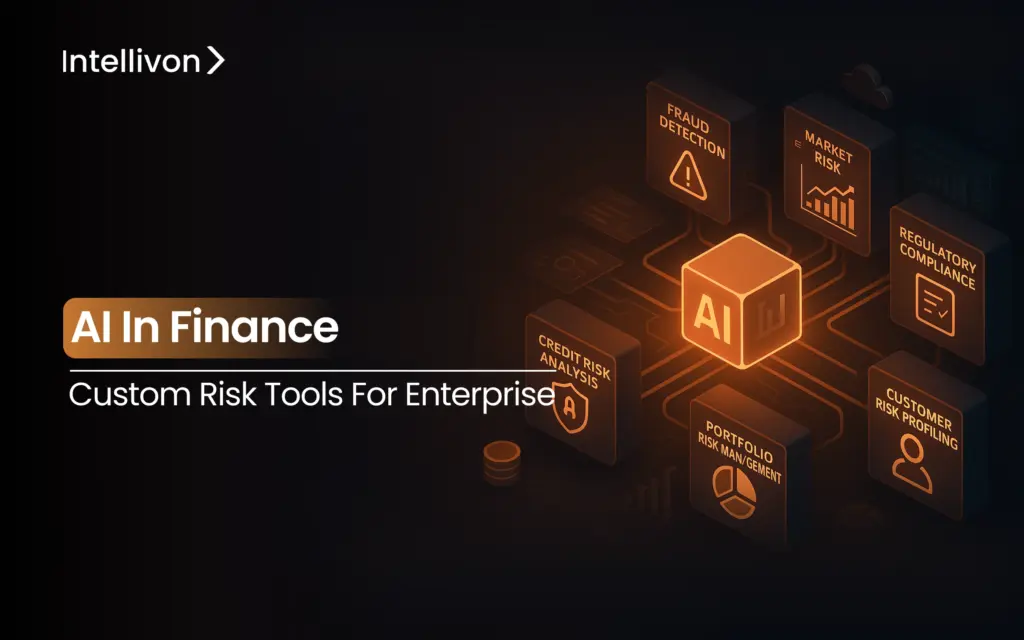
Financial enterprises are entering a period dominated by fast-changing rules, more cyber threats, and a more complex dynamic market. Traditional standardized risk management tools no longer fit the problems. Rather, AI-powered custom risk tools tailored to fit unique enterprise operations are constantly being adopted by leading organizations. In March 2023, the Silicon Valley Bank announced a $1.8 billion loss on the sale of bond holdings and plans to raise additional capital. The cause? Poor financial risk management. Yet, 60% of financial enterprises are still primarily relying on traditional risk tools for risk management, which were designed for yesterday’s problems. This is where AI is reshaping the financial risk landscape when integrated with custom risk tools. AI is not just accelerating the detection of risk but redefining how institutions anticipate, quantify, and respond to it. The question is no longer whether to adopt AI in finance, but whether your current systems are agile enough to withstand what’s coming next. In this blog, we will cover how AI-powered custom risk tools are addressing these anomalies, our approach to building and implementing risk tools for your financial needs, and some emerging trends in this area. Intellivon’s AI experts create custom solutions to meet your enterprise risk management needs. The Right Time To Use AI Custom Risk Tools For Financial Enterprises The global AI model risk management market was worth USD 5.5 billion in 2023 and is expected to grow to USD 12.6 billion by 2030, with an annual growth rate of 12.6% from 2024 to 2030. Numbers that suggest that AI-powered custom risk tools are driving the future of financial enterprises: In 2025, 85% of financial institutions are using AI in some part of their operations, up from 45% in 2022. 60% of these will apply AI in multiple areas, including risk management. 75% of banks with over $100 billion in assets are expected to fully adopt AI strategies by 2025, focusing on risk management, compliance, and customer analytics. More than 60% of financial institutions have already integrated AI into their operations by early 2025, with common uses like fraud detection, credit risk assessment, and risk management support. 91% of U.S. banks use AI for fraud detection, demonstrating AI’s effectiveness in real-time threat identification and prevention As financial enterprises swiftly adopt AI-driven custom risk tools, this might be the right time for your enterprise to invest in the right risk management partner. With over 11 years of expertise, Intellivon pioneers AI-driven risk management solutions, leveraging advanced technologies like ML, anomaly detection, and predictive modeling to build custom tools that help financial enterprises proactively manage evolving risks. Understanding the Financial Risk Landscape in 2025 The financial world in 2025 is fast, unpredictable, and highly connected. For large enterprises, this creates a serious challenge. Risks can appear suddenly, from many directions, and old systems are struggling to keep up. Many financial institutions still depend on traditional tools to manage risk. These systems were built for a slower time and often cannot handle the volume, speed, or variety of today’s data. As a result, some of the biggest risks go undetected until it is too late. The Types of Risks Financial Enterprises Face Today Enterprise-level risk is not limited to the stock market or interest rates. It now includes several other major areas: 1. Market Risk Changes in stock prices, interest rates, or currency values can impact financial operations instantly. With the rise of automated trading, markets move faster than ever, and it’s harder to predict those shifts using old methods. 2. Credit Risk This happens when borrowers or customers fail to pay what they owe. Traditional credit checks often miss warning signs that more advanced tools could catch earlier. 3. Operational Risk Mistakes, system errors, or process failures inside the company can disrupt services. As more work moves online, problems with technology or third-party vendors can cause serious delays or losses. 4. Cyber Risk Hacking, fraud, and data breaches have become regular threats. As technology grows more complex, so do the methods used by attackers. Standard IT tools often fall short of stopping these advanced risks. Speed and Complexity Are the Biggest Challenges Financial institutions collect a huge amount of information every day. But having data is not the same as understanding it. Most legacy systems cannot process live updates or make quick decisions. They rely on fixed rules and historical patterns, which no longer reflect today’s fast-changing environment. Lessons from the Failure of Older Risk Models One example is the Value-at-Risk (VaR) model, which many firms used to estimate how much they could lose on investments. During the 2020 market crash, this model failed to give accurate warnings. It could not handle the unusual and sudden changes brought on by the global crisis. This led to large losses for some institutions that had trusted it too heavily. Why a New Approach to Risk Is Urgently Needed The world has changed, but many financial risk tools have not. Companies that continue to rely on outdated systems are putting themselves at risk. What is needed now are smarter, faster, and more flexible solutions that can keep up with the pace of modern finance. Why Custom Risk Tools Outperform Traditional Solutions AI-powered custom risk tools offer a more targeted, responsive, and secure foundation for enterprise risk strategy. Built specifically for each organization’s operations and environment, these solutions provide measurable benefits that go far beyond what standardized platforms can offer. 1. Built To Fit Your Enterprise Issues AI-powered custom risk tools are tailored to match the exact structure and workflow of a business. Whether an institution operates across multiple jurisdictions or serves niche asset classes, a customized platform allows risk models to reflect these specifics. This avoids the need for process adjustments that often come with generic systems. For example, a global bank can embed its proprietary scoring methods, connect directly with its internal data architecture, and build real-time reporting dashboards without having to reshape operations to fit someone else’s model. This level of precision ensures the
How To Build AI Workflows For Enterprises
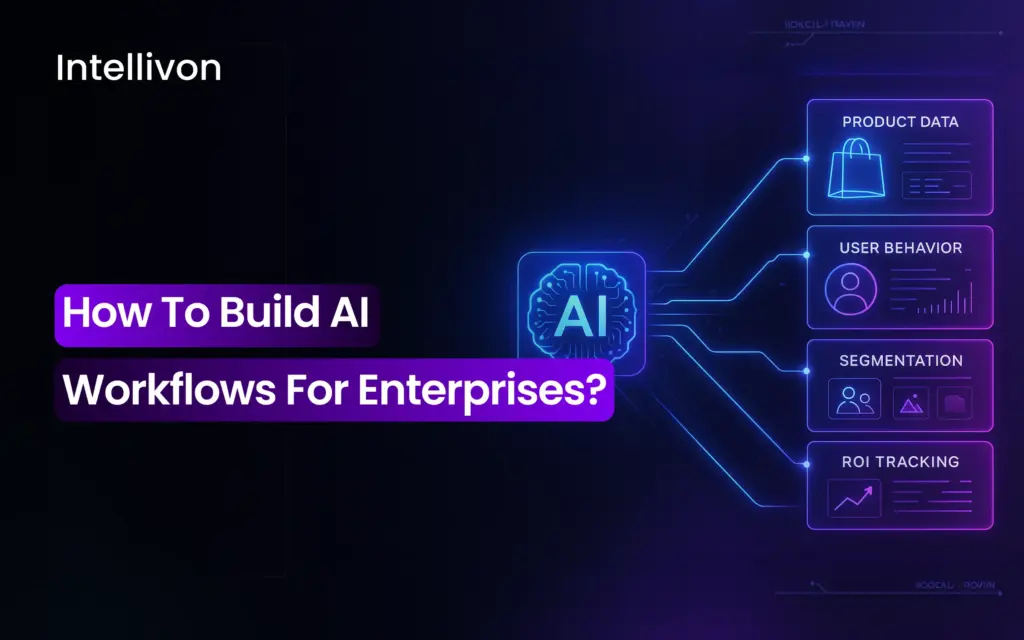
If your enterprise is still dependent on manual workflows, you are seriously lagging behind. 80% of enterprises out there are already leveraging AI to automate all their workflows, leading to faster, accurate results at half the operational costs. Take, for instance, Deloitte, one of the Big 4 accounting firms, with AI, they have reduced management report prep time from 5-8 days to 1 hour. Or even the Colombian multinational financial services holding company, Bancolombia, that saved 127,000 hours annually and reduced provisioning costs by $19M by using AI in their workflows. These enterprise trailblazers are paving the way for 100% AI-automated workflow environments, and others are already following suit. But how do leading enterprises actually build these intelligent workflows? What does it take to move from manual processes to a fully automated, AI-driven operation? In this blog, we’ll unlock the secrets behind AI workflow automation for enterprises, exploring proven strategies, real-world success stories, and the step-by-step blueprint to help your organization harness the full power of AI. Intellivon’s cutting-edge AI solutions have helped over 50 enterprises to automate workflows and achieve scalable real-world impact. Why AI Workflows Are Crucial for Enterprise Success The global market for workflow automation was valued at USD 19.76 billion in 2023 and is projected to grow to USD 45.49 billion by 2032. This represents a compound annual growth rate (CAGR) of 9.71% between 2024 and 2032. Some other staggering market insights surrounding the AI Workflow Automation market includes: Market Growth: The global workflow automation market is growing rapidly, with a projected increase of 21.55% annually. Market Size: The market was valued at $19.76 billion in 2023 and is expected to reach $51.19 billion by 2030, and $45.49 billion by 2032. Investor Interest: Over 2,600 investors have participated in more than 2,800 funding rounds, with the average round size being $8.4 million. Productivity Boost: Industries that have heavily integrated AI workflows report up to 4.8 times greater labor efficiency growth compared to others. Error Reduction: AI-driven automation can cut human errors by nearly 50%, improving overall accuracy and performance. Cost & Revenue Impact: Businesses see an impressive return on investment (ROI), ranging from 30% to 200%, within the first year of adopting AI workflow automation. Here are some reasons why integrating AI workflows for enterprises is crucial right now: 1. AI as a Competitive Advantage AI workflows allow businesses to automate both routine and complex tasks, helping them outpace competitors. Unlike traditional automation, AI adapts to evolving needs, processes unstructured data, and delivers personalized customer experiences. Enterprises that adopt AI-driven workflows gain a significant edge, providing faster, more efficient services in a data-driven market. 2. Scalability and Efficiency AI workflows are scalable, enabling businesses to extend automation across various departments and regions seamlessly. Cloud-based AI platforms dynamically adjust resources to match demand. This scalability, combined with AI’s ability to automate high-volume tasks, frees up human resources for strategic work, boosting productivity and operational efficiency. 3. Handling Unstructured Data AI workflows excel at managing unstructured data like emails, voice conversations, and free-form text, which traditional automation tools can’t handle. AI improves decision-making by analyzing both historical and real-time data, optimizing processes like resource allocation, risk assessment, and exception handling. 4. Adaptability and Continuous Improvement AI workflows are not static. Unlike rule-based systems, AI continuously evolves with new data and changing business environments. This adaptability ensures that enterprises can optimize workflows over time, staying agile and competitive in a fast-moving business world. 5. Enhanced Accuracy and Reduced Errors AI-driven automation reduces human error in tasks like data entry, compliance checks, and financial transactions. By ensuring more accurate and reliable operations, AI minimizes costly mistakes and enhances operational efficiency. 6. Cost Reduction and ROI AI workflows help businesses lower operational costs by automating labor-intensive tasks and improving resource allocation. Many enterprises report a return on investment within a year of AI implementation, with cost reductions of up to 10% and revenue growth of more than 10%. 7. Real-World AI Workflow Examples HSBC: Implemented AI to improve financial crime detection, increasing risk detection by 2–4 times and reducing false positives by over 60%. Kent Community Health NHS Foundation Trust: Saved £700,000 and freed up 45,000 hours by automating administrative workflows with AI. Vale: Automated processes for a 234,000-person workforce, saving 121,000 hours and $5 million annually. Coca-Cola: Used AI-powered marketing tools to optimize campaigns, boosting customer engagement and efficiency. 8. Enhancing Customer Experience AI-powered chatbots and virtual agents provide personalized, instant support, improving customer satisfaction and loyalty. This application of AI automation is especially valuable in industries like retail and telecom, where fast personalized service is critical to customer retention. Key Components of Building Effective AI Workflows for Enterprises Building AI workflows in enterprise environments requires a thoughtful approach to integrating various technologies and data sources. Below are the key components that make AI workflows in enterprise settings not just effective but transformative for business operations. 1. Data Integration Integrating data from sources like databases, ERP systems, CRM systems, cloud platforms, and IoT devices is critical for AI workflows in enterprise environments. Simplifying this process with AI-powered ETL (extract, transform, load) pipelines and intelligent data cataloging ensures a secure and scalable data flow across platforms. This also eliminates data silos and maintaining high-quality, ready-to-process data for AI systems. 2. Automation of Repetitive Tasks AI workflows in enterprise settings excel at automating repetitive tasks such as data entry, invoice processing, and report generation. By leveraging advanced workflow engines, Intellivon helps enterprises reduce manual errors and speed up processes, freeing employees to focus on strategic initiatives. Automation is integrated directly into existing business applications, ensuring consistency and efficiency in task handling. 3. Machine Learning Models Machine learning models form the core intelligence of AI workflows, allowing systems to adapt and predict outcomes based on enterprise-specific data. Intellivon enables organizations to build, train, and deploy custom machine learning models tailored to their unique needs. These models continuously evolve through automated retraining, ensuring their relevance and accuracy as business conditions change. 4.
Building a Dynamic Pricing System Based on Real-Time Market Data
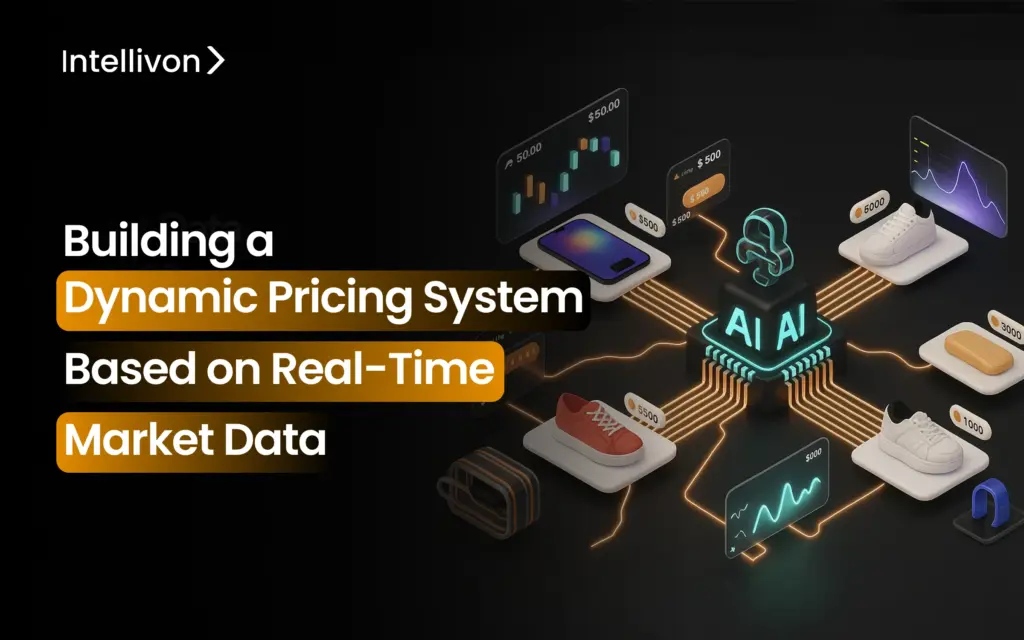
Leading enterprises are struggling to keep up with the fast pace of price change. By the time they adjust prices to match market standards, the market has already shifted again, leaving them a step behind and profit slipping through the cracks. Meanwhile, competitors who can adapt in real-time are capturing more market share and maximizing their margins. For instance, these leading giants are pioneering the retail space due to their adaptive pricing solutions: Uber holds 76% of U.S. rideshare market, dominating on-demand transportation services. Airbnb controls 44% of global short-term rental revenue, outpacing hotels and platforms. Costco owns 60% warehouse club market, with the highest average sales per store. Amazon captures 38% of U.S. e-commerce, five times larger than the next competitor. Markets are moving too fast. Customer expectations are constantly evolving. Supply chains remain unpredictable. In this landscape, the need for dynamic pricing systems becomes urgent. Traditional models simply cannot respond to sudden changes in demand or supply disruptions without incurring revenue loss or lowering profit margins. In this blog, we will cover why your retail enterprise needs a dynamic pricing system in place, how it will benefit you, how we build and integrate such software into existing legacy systems, and how to keep your pricing model risk-free. As a provider of AI pricing solutions for enterprises worldwide, Intellivon’s pre-vetted AI experts focus not only on the technology stack but also on the strategic alignment that goes into building scalable, intelligent pricing systems that adapt in real-time and align with broader enterprise goals. Why Real-Time Pricing Is Essential for Enterprises Now The way enterprises approach pricing has undergone a fundamental change. Traditional models relied on fixed or seasonal pricing, with updates planned weeks or months in advance. Today, that level of rigidity no longer works. Dynamic pricing systems introduce a more responsive approach, where prices adjust continuously based on real-time factors like demand, competitor movements, inventory levels, and market trends. The dynamic pricing software market was projected to reach $3.53 billion in 2025, growing at a rapid CAGR of 15.8%. By 2029, it is expected to hit $6.29 billion. 25–30% of UK and European businesses use dynamic pricing systems in 2025. Adoption rates are increasing year-on-year across enterprise sectors. Amazon updates prices every ten minutes using advanced machine learning. Walmart is deploying digital price tags for instant, automated pricing updates. Thousands of staff hours saved through real-time price change capabilities. Zara and Target have fully integrated AI-based dynamic pricing systems. Integrating an AI and ML-led dynamic pricing system is the right move for your business now because of the following evolving trends: 1. Market Volatility Demands Speed and Precision Today’s markets are too unpredictable for static pricing models. From inflation spikes to sudden shifts in consumer demand, enterprise pricing must respond in real time. Dynamic pricing systems enables companies to adjust quickly and accurately, thereby protecting margins and remaining competitive in rapidly changing conditions. 2. Real-Time Pricing Prevents Margin Erosion Outdated pricing often leads to undercharging in high-demand periods or overpricing during slowdowns. This erodes profitability over time. With a real-time pricing engine, enterprises can continuously align prices with market demand, ensuring they optimize for both revenue and margin at scale. 3. Region-Specific Pricing Complexity Is Growing Multinational enterprises face different pricing pressures in every market. UK energy firms deal with volatile wholesale prices and regulation, while U.S. retailers manage seasonal demand spikes. A dynamic system can account for these regional nuances, applying localized pricing logic without manual intervention. 4. Customers Now Expect Fair, Flexible Pricing Enterprise buyers and consumers alike are more price-aware than ever. They expect pricing to reflect current value, usage, and availability. Dynamic pricing enables fair, transparent adjustments based on real-world factors, building trust and reducing churn. 5. Static Pricing Slows Enterprise Decision-Making Without automated, responsive systems, pricing teams spend valuable time reacting to changes manually. A well-integrated dynamic pricing model allows for strategic oversight while letting algorithms handle real-time updates. This frees up resources and enables faster decision-making at the executive level. 6. Data-Driven Pricing For enterprises focused on transformation, pricing is often an overlooked pillar. Yet it ties directly to revenue, customer experience, and operational efficiency. Building a market-driven pricing system ensures that pricing evolves alongside digital initiatives, powered by AI and intelligent data strategy. How Dynamic Pricing Systems Work In Enterprises The backbone of a dynamic pricing system consists of several components working together seamlessly, all designed to process real-time data and optimize pricing decisions. Below is an overview of how AI-driven pricing engines leverage advanced technologies to adjust prices dynamically and effectively. 1. Data Ingestion Layer The data ingestion layer is where real-time market signals enter the system. This includes everything from competitor pricing and customer behavior to supply chain disruptions, weather forecasts, or regional economic changes. Using APIs, third-party data sources, and internal data systems, this layer collects vast amounts of data, ensuring the pricing system is always up-to-date and ready to react. For example, a retail business can pull in live competitor prices, inventory levels, and customer traffic data to make timely adjustments. This constant flow of data enables real-time, responsive pricing strategies. 2. Predictive Pricing Engine Once the data is ingested, it’s time for the predictive pricing engine to take over. This is where machine learning models come into play. These models analyze historical data and current inputs to forecast future trends in demand, customer price sensitivity, and market shifts. By doing so, they can predict the optimal price for a product in any given moment. For instance, if demand for a product suddenly spikes, the system can automatically raise the price to maximize revenue, while also accounting for factors like stock levels and competitor pricing. 3. Business Rules Engine While machine learning does the heavy lifting of prediction, it’s important to have boundaries in place. This is where the business rules engine comes in. It sets predefined rules to ensure the dynamic pricing engine operates within acceptable limits. For example, companies may set maximum price hikes
Developing a Personalized Product Recommendation Engine using AI
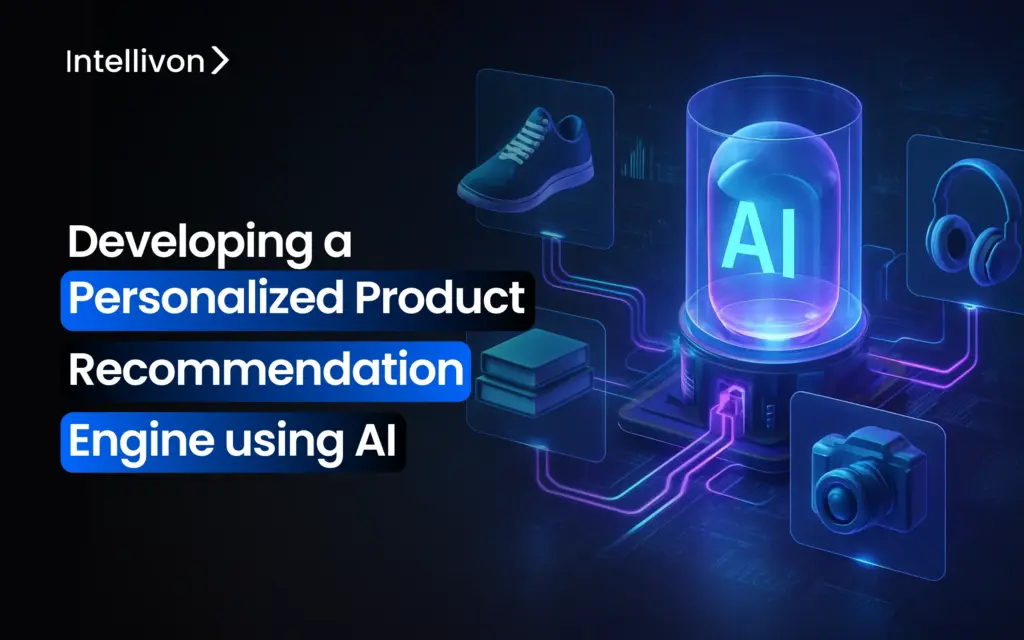
Leading the market as a retail enterprise means constantly scaling existing platforms and creating highly individualized shopping experiences that lock in customers for the long run. The real challenge is balancing the growing amount of data, delivering real-time personalized product recommendations, and accurately predicting future preferences. And when you have a fast-growing customer base, as well as a wide range of SKUs, recommending the exact product that your customers need becomes increasingly impossible. This is where AI-based personalized product recommendation engines come into play. These engines analyze vast amounts of consumer data, allowing retailers to predict and suggest products that mirror each shopper’s unique product preferences. For instance, some of the world’s largest retail brands have benefited from this integration. 35% of Amazon’s revenue is generated through its AI-based recommendation engine. Sephora saw a 25% increase in add-to-basket rate and a 35% increase in conversions after implementing virtual try-on features and AI-powered personalized recommendations. In this blog, we’ll explore how retail enterprises can leverage these AI-powered recommendation engines to manage growing data, accurately predict customer preferences, and hyper-personalize recommendations. We will also look at how these AI-powered engines work, why you should get them integrated into your platform, how to develop the engine, and some key challenges along with their solutions. With Intellivon’s deep expertise in implementing and scaling enterprise-grade AI solutions tailored to retail needs, our pre-vetted AI experts help your enterprise in driving hyper-personalized customer journeys. Why Your Retail Enterprise Needs Personalized Product Recommendations AI-powered personalized shopping experiences help businesses keep customers coming back, with up to 44% of repeat purchases driven by this approach. To boost loyalty and sales, it’s important to give customers a personalized experience every time they shop with you. This makes them feel valued and encourages them to return. Personalized shopping experiences can boost retail revenue by 40%. Product recommendations can lead to a 300% revenue increase, 150% rise in conversion rates, and 50% growth in average order values. AI adoption in eCommerce was valued at $5.81 billion in 2022, expected to reach $22.6 billion by 2032 (14.60% CAGR). 71% of customers expect personalized interactions. 76% of customers feel frustrated when their personalization expectations aren’t met. 63% of shoppers say AI-driven product recommendations influence their purchases. 83% of consumers are open to browsing or buying products through messaging. Personalized recommendations help customers find products they love, leading to higher cart values. Personalized product recommendations contribute up to 31% of e-commerce revenue. Companies that excel at personalization generate 40% more revenue than those that don’t. Personalization is key to creating a customer-first retail experience. AI-driven recommendations and customized shopping journeys have been shown to boost engagement, improve retention, and increase average order value. For large enterprises, investing in personalized experiences is essential for staying competitive in today’s rapidly evolving retail market. Intellivon offers tailored AI solutions that empower large retail enterprises to deliver customized product recommendations, enhancing customer engagement and driving sales growth. How AI Product Recommendation Engines Work At the heart of AI product recommendation engines are algorithms that analyze user data to suggest relevant products. They work by analyzing user data, such as browsing history and previous purchases, to understand preferences. For example, Amazon suggests products based on past purchases, while Spotify recommends music based on your listening habits. This data is stored in cloud systems like AWS or Google Cloud, allowing it to scale as needed. Once the data is collected, it’s processed using machine learning and other techniques to identify patterns. These patterns help predict what a user might like next, allowing the system to offer personalized recommendations. The system then filters and presents these suggestions, which become more accurate as it gathers more data over time. 1. Types of AI Product Recommendation Engines: AI personalized product recommendation systems come in various types, each designed to meet specific needs and improve product suggestions. They are segregated into the following types: 1. Collaborative Filtering This method suggests products based on the preferences of users with similar tastes. For example, if Customer A and Customer B have similar purchase histories, the system might recommend products that Customer B bought to Customer A. It’s like getting advice from a friend with similar tastes. 2. Content-Based Filtering This approach recommends products based on characteristics that the user has shown interest in before. For instance, if a shopper frequently buys running shoes, the engine will suggest other running shoes or related products like athletic wear or accessories. Essentially, it matches product features with user preferences. 3. Hybrid Models Many recommendation engines combine collaborative filtering and content-based filtering to provide more accurate results. By blending these approaches, the system can refine its suggestions, offering a more personalized experience and improving recommendation accuracy. 4. Deep Learning Deep learning models analyze vast amounts of data to identify complex patterns in customer behavior. These systems go beyond simple preferences, learning from interactions and continuously refining recommendations. For example, deep learning can predict a customer’s future interests based on subtle, long-term patterns in their activity, providing highly personalized suggestions that evolve over time. 5. Knowledge-Based Systems Knowledge-based recommendation engines rely on explicit information about a user’s needs and preferences. For instance, if a customer is searching for a specific product, such as a laptop with certain specifications, the system will recommend products that meet those exact criteria. This method works well when users have specific requirements or when there’s limited historical data available. 2. Types of Data Used in Building AI Recommendations Data is the foundation of any successful AI personalized product recommendation engine. Without high-quality data, the system’s recommendations will fall short. Here’s how different types of data play a crucial role: 1. User Behavior The way customers interact with your site, what they click on, how long they stay on a page, and which products they view or purchase. helps the system understand their preferences. This behavioral data enables the engine to fine-tune its suggestions and make them more relevant over time. 2. Purchase History Knowing what
AI in Enterprise Communication Systems – Development And Process
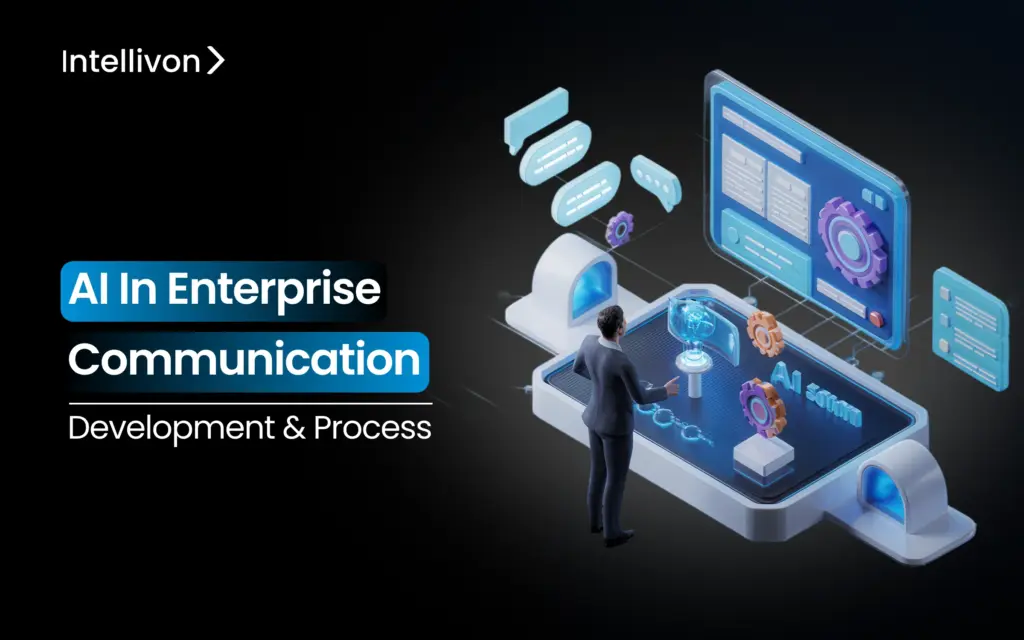
Enterprise communication has undergone a seismic shift in the past decade. Gone are the days when internal messaging and basic VoIP calls sufficed. Today, the landscape is dynamic, cloud-based, and AI-enhanced, shaping how employees collaborate, share knowledge, and engage with customers. Artificial Intelligence (AI) is redefining the boundaries of what’s possible in enterprise communication. From automating responses to providing intelligent insights, AI is more than just a tool it’s a strategic asset. This article explores how AI is developed and integrated into communication systems, the benefits and challenges, and what the future holds. Understanding Enterprise Communication Systems Enterprise communication systems (ECS) encompass the tools, software, and processes that facilitate internal and external business communication. These systems can include: Emails Instant messaging platforms (e.g., Slack, Microsoft Teams) VoIP and video conferencing tools (e.g., Zoom, Cisco WebEx) Unified communication systems (UCaaS) The primary goal is to ensure seamless, secure, and efficient communication across departments, time zones, and even languages. With digital transformation accelerating, these systems must now support hybrid work environments, remote collaboration, and 24/7 global operations. The Role of AI in Modern Communication Platforms AI brings automation, intelligence, and personalization to enterprise communication. Here’s how: Natural Language Processing (NLP) enables machines to understand, interpret, and generate human language. Machine Learning (ML) powers predictive text, smart replies, and content recommendations. Computer Vision supports facial recognition, emotion detection, and meeting analysis. Speech Recognition transcribes meetings, translates conversations, and assists with accessibility. These technologies enhance real-time collaboration, streamline workflows, and provide actionable insights. Development of AI-Powered Communication Systems System Architecture Modern communication systems are often built using microservices and cloud-native infrastructure. This modular approach allows businesses to add or upgrade AI components without disrupting the entire system. AI Technologies Involved NLP engines (e.g., BERT, GPT) Speech-to-text and text-to-speech tools (e.g., Google Speech, Amazon Polly) Sentiment analysis APIs Voice biometric security layers Integration with Legacy Systems Most enterprises already have established communication platforms. AI integration is often achieved via APIs or middleware, allowing companies to modernize without complete overhauls. Key AI-Driven Use Cases in Enterprise Communication Intelligent Chatbots Deployed in HR and IT departments, AI chatbots handle routine queries, freeing human staff for complex issues. Advanced bots can escalate issues, analyze queries for sentiment, and even learn from new inputs. Voice Assistants Voice-activated commands help employees schedule meetings, set reminders, or search documents, reducing reliance on manual inputs. AI-Powered Transcription & Translation Real-time transcription helps teams document meetings accurately. Integrated translation tools enable smooth multilingual communication, vital for global teams. Sentiment Analysis & Employee Feedback Analyzing employee communications (emails, messages) for mood and tone helps HR teams track morale and intervene when needed. Smart Meeting Scheduling & Summarization AI reads calendars, detects conflicts, and suggests optimal meeting times. Post-meeting, AI tools generate concise summaries with action points. Development Process: From Ideation to Deployment Planning & Requirement Gathering Start by identifying communication pain points. Define what problems AI should solve, like slow response times, miscommunication, or feedback bottlenecks. Choosing the Right AI Stack Popular tools include TensorFlow, PyTorch, Dialogflow, and AWS Lex. The choice depends on performance, scalability, and integration capabilities. Data Collection & Model Training Communication data like emails, call transcripts, and chat logs serve as training data. Ethical concerns, especially around privacy, must be addressed by anonymizing and securing data. Testing & Validation Test models in sandbox environments using real-life scenarios. Address any bias or misclassification. Deployment & Scalability Use CI/CD pipelines and containerization (e.g., Docker, Kubernetes) to deploy and manage AI components across communication channels. Monitoring & Continuous Improvement Set up feedback loops for continuous learning. Monitor user interactions to retrain and optimize models over time. Benefits of AI in Enterprise Communication Faster decision-making with real-time insights Reduced manual workload via automation Enhanced personalization in interactions Improved collaboration across departments and locations Scalability to support growing teams and global operations Challenges & Ethical Considerations Despite its potential, AI comes with challenges: Privacy concerns around data usage Bias in AI models due to skewed training data Over-reliance on automation, leading to communication gaps Compliance with regulations like GDPR and HIPAA Addressing these requires clear policies, ethical frameworks, and regular audits. Case Studies: Companies Leveraging AI in Communication Microsoft Teams uses AI for background noise suppression, real-time translation, and meeting recaps. Slack integrates GPT for smarter responses and task summarization. Google Workspace leverages Smart Compose and Smart Reply for predictive typing. Zoom employs AI to generate meeting transcripts and detect participant engagement. Future Trends and Innovations to Watch Emotionally intelligent AI that detects mood and adjusts responses accordingly Real-time multilingual collaboration with near-perfect translation accuracy Generative AI for meeting documentation, turning transcripts into reports Integration with AR/VR for immersive, AI-supported communication spaces FAQs: People Also Ask 1. How is AI transforming enterprise communication? AI automates routine tasks, provides real-time insights, and enhances personalization, making communication faster and more effective. 2. What are the top AI tools used in corporate communication? Tools like Dialogflow, Microsoft Azure AI, Zoom AI Companion, and Slack GPT are widely used for enhancing communication workflows. 3. How do AI chatbots improve internal workflows? They handle FAQs, route requests, and provide 24/7 support, improving efficiency and freeing up human resources. 4. What are the privacy concerns with AI in communication? Data handling, storage, and processing must comply with regulations and ethical standards to prevent misuse or breaches. 5. What is the ROI of implementing AI communication tools? Companies report improved productivity, faster response times, and better employee satisfaction, often leading to significant cost savings.
